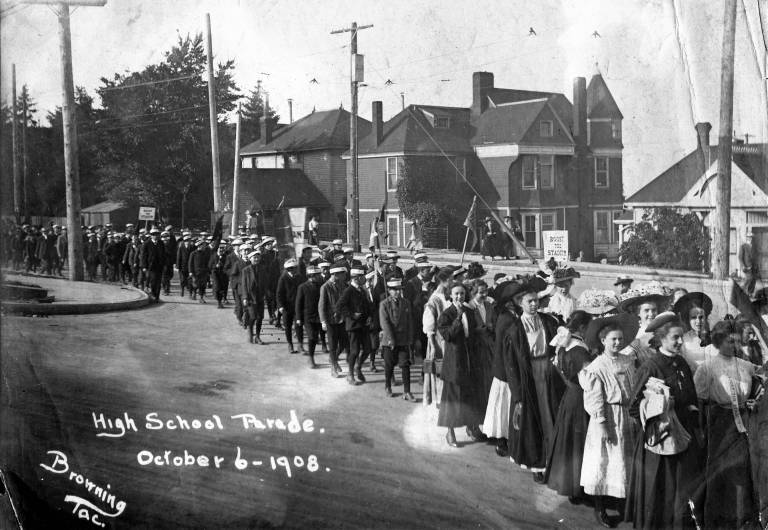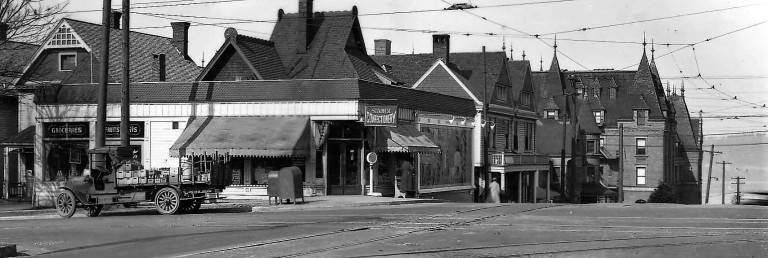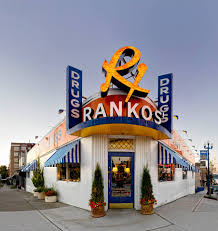
It could be argued that Tacoma’s Stadium District started with a parade. Here it is, marching along almost exactly 112 years ago on October 6 1908. When classes started for just the third year of Tacoma’s dazzling new Chateauesque High School the student body fell in with architect Frederick Heath on the idea of building a stadium into the hillside next to the academically repurposed hotel building. The monumental real estate failure of 1890

was reimagined as an educational landmark after the turn of the 20th Century and in April 1904 voters passed a bond issue to restore the ruins of the Tourist Hotel as Tacoma High School.
Now the community was ready to double down on the rash venture and raise $100,000 to sculpt a supersized amphitheater into the site (Heath and the School Board had actually planned for the Stadium very early but the cost overruns on the building dashed the notion). 2000 school kids marched in the “Boost the Stadium” parade from the high school into the downtown business district in a not exactly spontaneous demonstration of support for the project. The school district arranged for a half day of classes and the Tacoma Musicians Union managed to provide a marching band which helped provide tempo for the quick step chant Boost for the stadium!, stadium!, stadium!. The deal for downtown businesses was that they sign a $10 promissory note to the district and get a seat for every event in the stadium for the first five years. The grander pitch was that the new stadium would serve the entire community for civic events, pageants and extravaganzas. By Thanksgiving the campaign had raised $45,000 and even when bids came in way above estimates and cynics claimed the whole hillside would collapse, work started on the transformation

of what was known as “Old Woman’s Gulch”. Sluicing and steamshovel work proceeded through the wet winter and pile driving started in the Spring of 1909. By the end of summer the gulch that once required a trestle for Tacoma Avenue to cross had vanished and the land-form of a 25,000 seat stadium was evident. The ramparts and concrete seating bowl were finished by the end of the school year in 1910 and everything turned to the opening events and dedication that started on June 10th and continued through most of the summer. To say that the entire city was breathlessly, irrationally enthusiastic about the new stadium would be a gross understatement. Here’s one newspaper account of the dedication dance finale directed by Miss Helen Parkhurst:

“Thirty-five thousand girls, attired in brilliant red, yellow and black, pirouetted onto the field with castanets and tambourines tinkling. The dance itself had the audience on its feet when it came to the supposed end. But then the band started another tune and the dancers broke formation; started running from the field the onlookers supposed. But not so. Instead they ran with the precision of a Rockette chorus to their second positions and as the music reached its final crescendo a gigantic living “Tacoma” was spelled out before the surprise and cheering 80,000.”
There were 18,611 students in the entire Tacoma school district in 1910, Tacoma’s population was 83,734 and the number of seats in the bowl was 23,486 (or 32,000 according to the same newspaper). But who’s counting. Safe to say there weren’t ten things to hate about the stadium in the entire city.

By 1913 Tacoma’s high school and stadium were much more than just local landmarks and event venues. They were place makers for the city-changing the way visitors thought of the Northwest seaport city and reshaping the way locals moved around. With the Tacoma Avenue trestle gone the busiest streetcars to Old Town, the North End and cross town 6th Avenue all radiated from the Stadium District. When there was a big event or game at the Stadium, the district became choked  with thousands-even ten thousand people at a time. By the early 1920 there was a thriving business district around Division and Tacoma Avenue and that year the millionth ticket holder sat in the bowl. Presidents Roosevelt, Harding and Wilson spoke at the stadium. Billy Sunday preached, Babe Ruth batted, Jack Dempsey boxed and John Phillips Sousa conducted in the stadium. It hosted football games, rodeos, military displays, flower pageants, fireworks displays, firemen’s conventions, track meets, passion plays, ice rink skating competitions, a simulated city bombing during World War Two and a performance of the “Burning of Rome” with chariots and bizarrely costumed centurions.
with thousands-even ten thousand people at a time. By the early 1920 there was a thriving business district around Division and Tacoma Avenue and that year the millionth ticket holder sat in the bowl. Presidents Roosevelt, Harding and Wilson spoke at the stadium. Billy Sunday preached, Babe Ruth batted, Jack Dempsey boxed and John Phillips Sousa conducted in the stadium. It hosted football games, rodeos, military displays, flower pageants, fireworks displays, firemen’s conventions, track meets, passion plays, ice rink skating competitions, a simulated city bombing during World War Two and a performance of the “Burning of Rome” with chariots and bizarrely costumed centurions.
Even though the skeptics that predicted the bowl would wash out someday were right (At least three times in 1932, 1949 and 1981) the stadium still defines one of America’s great architectural landmarks and setting. Tacoma is not a one trick pony with a single important historic place but when the game of unforgettable landmarks begins between cities we definitely have a home field advantage.
MARGINALLY EXPLAINABLE DIGRESSIONS
No real surprise that soon after Tacoma High School opened in 1906, followed by the stadium in 1910, a number of shops and businesses popped up at the busy streetcar crossing at Tacoma Avenue and Division. One of the first was a grocery at 101 Tacoma Avenue which sometime around 1913 expanded to include a confectionery shop on the corner.

Tacoma High changed its name to Stadium that year and by then selling candy and soda to kids made more sense than milk and the daily paper to streetcar commuters. By the 1920s, the grocery business was mostly done by delivery truck and Stadium Confectionery took over the key corner location. In 1936, Cora Scherzer and Alice Samson had the wood frame grocery torn down and built a fashionable brick and concrete building for their new Grey Goose Coffee Shop & Confectionery. Ice Cream and a full soda fountain was the new attraction but sadly, in the days of the depression instead of Starbucks, the enterprise didn’t make it.  The building was remodeled once before a young pharmacist named George Rankos opened for business in 1940 under the Rexall Drugs banner. Rexall was a national franchise that advertised broadly on radio and Tacoma was all about the new broadcast medium during and after the Second World War. George Rankos streamlined his building in a late Art Deco style and went big with neon and the Rexall colors and logo. It didn’t take long for him to add a full soda fountain, a tasty selection of candy and even a jukebox. The neighborhood landmark found room for a post office and even a telephone booth with folding doors and a ceiling light which are still there. In fact the whole Rankos ensemble is still there today operated by George’s son Greg and his grand daughter Liz. Its waiting for the streetcar.
The building was remodeled once before a young pharmacist named George Rankos opened for business in 1940 under the Rexall Drugs banner. Rexall was a national franchise that advertised broadly on radio and Tacoma was all about the new broadcast medium during and after the Second World War. George Rankos streamlined his building in a late Art Deco style and went big with neon and the Rexall colors and logo. It didn’t take long for him to add a full soda fountain, a tasty selection of candy and even a jukebox. The neighborhood landmark found room for a post office and even a telephone booth with folding doors and a ceiling light which are still there. In fact the whole Rankos ensemble is still there today operated by George’s son Greg and his grand daughter Liz. Its waiting for the streetcar.
∇∞∋
The versatility of Stadium Bowl was on full display in January 1947 when the Control Line Model Airplane Meet was held on the playfield. Gasoline powered model airplanes were a nerd’s best friend in the years just after the war and if you read every page of every issue of Modern Mechanics, your own airplane

on a string was about the coolest thing there was. Next best was having a big stadium to fly it in with a crowd of other early day big bang theorists around to watch and analyze every maneuver.
O K and if there was an even better rush, unimaginable really, it was having an actual rescue helicopter  fly over and then land right there in the stadium. Are you kidding me! A helicopter that lands right where you landed your model plane. You can walk right up and talk to the pilot!
fly over and then land right there in the stadium. Are you kidding me! A helicopter that lands right where you landed your model plane. You can walk right up and talk to the pilot!
Some related stories:



Do know which ship is lying at anchor below the bowl? It is a Tennessee-class armored cruiser and I am betting that it is the Washington (later, renamed “Seattle”) as she was in port frequently during this era. I have photos of Washington’s crew participating at the American Lake military training exercises before 1908.
LikeLike
Great blog poost
LikeLike